| Published
on 18
Oct
2012 |
All rights reserved.
|
|
|
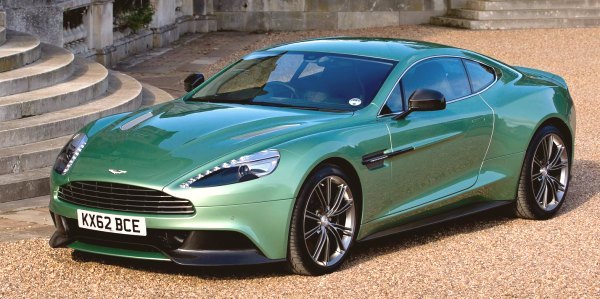
|
|
Vanquish
Mk2 is not as revolutionary as the original, but it is far better
finished, well rounded and easier to live with.
|
|
I really want to write
about Aston Martin One-77, the 750hp supercar and the most exclusive
Aston of this generation. However, its maker is probably not confident
that it could match other million-dollar exotica, so it had never
invited automotive journalists to test drive it. Without any driving
impression, we can only turn our attention to the next best Aston, the
new Vanquish.
This is not the first time the name Vanquish is used. The original was introduced in 2001 as the
most exotic model of Aston Martin. It employed an advanced chassis made
of
aluminum spaceframes and carbon-fiber transmission tunnel and
windscreen frame. A powerful V12 and semi-automatic gearbox provided
propulsion and a top speed of 190 mph. Ian Callum dressed it with a
brutal yet advanced design, whose influence is still evident to the
current generation Aston Martins. The Vanquish was a revolution to
Aston. It still enjoys the highest status in the mind of Aston
loyalists today, especially because its successor DBS never quite matched its breakthroughs
in technology, concept and style. That is not to say it was perfect.
No, it actually had quite a lot of flaws, such as a tricky handling at
the limit, hard ride, poor brakes and cheap interior, to name a few.
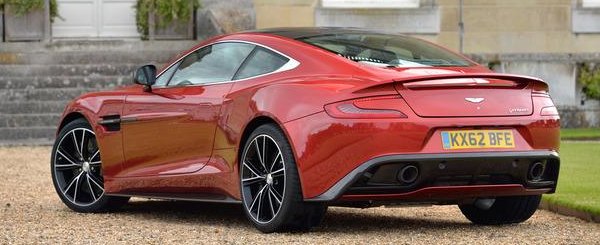
|
|
This
must be the best looking Aston since DB7.
|
|
The Vanquish Mk2 is quite different. It is not as
revolutionary as the original, unquestionably, but it is far better
finished, well rounded and easier to live with. You can drive it for
long distances from day to day without feeling uncomfortable or
tiresome. Its suspension can absorb all kinds of road surfaces without
showing twitchiness. Its gearbox, its steering and NVH suppression are
all engineered to serve the function of GT. It also provides
considerably more cabin and luggage space than the old Vanquish and
DBS.
Meanwhile, it is quite a lot more interesting to look and to study than
the DBS. Its exterior has enough curves to make the DBS dull, yet it is
gentler and more beautiful than the original Vanquish. In my opinion
this must be the best looking Aston since DB7. My only complaint is the
aggressive front splitters, which shout too loud about their
carbon-fiber construction and look out of place with the rest of the
design. Obviously, Marek Reichman needs the sense of aggression and
performance they brought to distinguish the Vanquish from the lesser
DB9 and V8 Vantage models. They managed that task well, if at the price
of harmony.
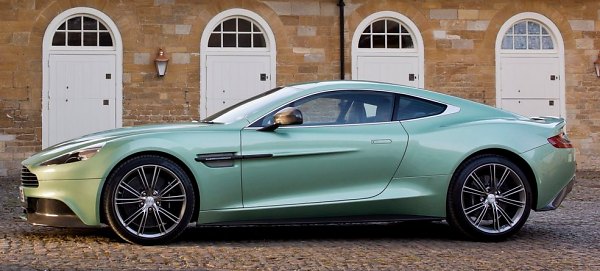
|
|
The
4th generation VH platform lifts torsional rigidity by 25 percent.
|
|
Many journalists criticized the new Vanquish for differing
little from the existing Virage, DB9 and DBS. That is quite true. Aston
Martin as an independent small company does not have the resources of
Ferrari or Porsche to invest. It has to use money with strong
self-discipline, yet to maintain sales momentum it has to roll out new
models every a couple of years. That is why we can see only small
progress on each iteration. For example, the VH (Vertical Horizontal)
platform has been around for 8 years since the birth of DB9. It still
serves the new Vanquish, albeit in the 4th generation (note: the 2nd
gen being DBS while the 3rd gen being Rapide and Virage). Aston claims
new aluminum spaceframe parts and the use of carbon-fiber components
have reinforced it, lifting its torsional rigidity by 25 percent
compare with DBS. Like the 3rd generation, its NVH suppression is far
better than the old car. Moreover, the Vanquish gets full carbon-fiber
body panels, including door shells. This offsets part of the weight
gained by the NVH engineering and resulted in a kerb weight of 1739
kilograms – about the same as an automatic DBS, although no match with
Ferrari F12 (1630 kg). Considering the improved comfort and quality it
brought, that is not too bad.
As before, the chassis rides on all double-wishbone suspensions
fashioned in aluminum. Adaptive damping system offers 3 stiffness
levels to choose from – Normal, Sport and Track. The stability control
now offers 3 stages and a very effective launch control is added for
the first time to aid standing start. The steering remains hydraulic
assisted, but its gearing is quickened from 3.0 to 2.6 turns
lock-to-lock. Braking continues to be served by Brembo carbon-ceramic
brakes.
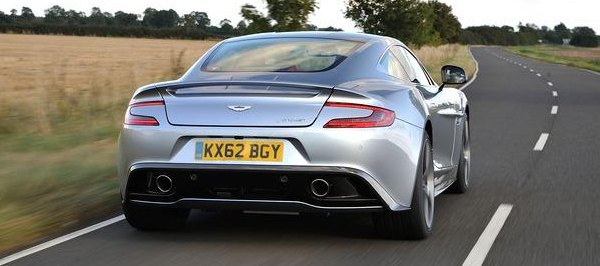
|
|
You
can drive it for long distances from day to day without feeling
uncomfortable or tiresome.
|
|
The Cologne-built 5935 c.c. V12 is no match with the
brand-new direct-injected V12 serving Ferrari F12, of course, but it
has finally
received some modern touches – variable valve timing! And it is present
on both intake and exhaust cams. This can be described as a notable
achievement as, you might remember, the Aston V12 was originally
derived from a pair of Ford 3-liter Duratec V6 serving the 1996 Taurus!
Besides, it gets larger intake manifolds and throttle bodies and
uprated fuel pumps to serve a maximum output of 573 hp at 6750 rpm, up
55 horses from the DBS. Maximum torque increases by 37 lbft to a total
of 457.
Theoretically this should bring a top speed beyond the DBS' 191 mph.
Unfortunately, Aston decided to skip manual gearbox and serves the
Vanquish with only a 6-speed Touchtronic automatic transaxle. The
official reason is that the ZF automatic is as good as manual yet more
versatile. The real cause is no one opted for manual gearboxes these
days, and Aston could not afford to engineer a dual-clutch gearbox at
the moment. No matter what reason, the outcome is a top speed reduced
to 183 mph – or 5 km/h below the magical 300 km/h mark. As a result, we
can doubt its claim as a supercar.
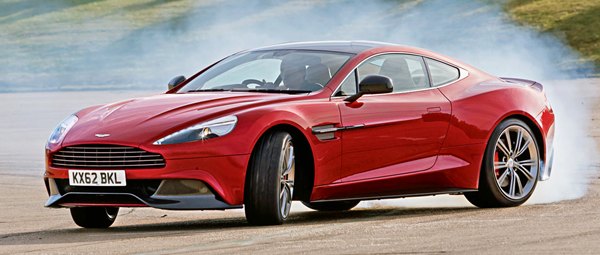
|
|
At
the limit, its behavior is pretty benign, contrasting to the
twitchiness of DBS.
|
|
However, it is no doubt that the Vanquish is better than its
predecessor to drive by some margin. The V12 now provides more torque
at lower rpm. Even though it lacks the explosiveness of a real supercar
like Ferrari F12 or Lamborghini Aventador, its power delivery is still
pleasantly linear and flexible. Its sound is truly magnificent, more
delicious than turbocharged motors with less cylinders, especially when
Sport mode opens its exhaust by-pass valves. With a 0-60 mph time of
4.0 seconds, you can hardly complain for lack of real-world performance
either.
Thanks to the stiffer chassis, better suspension isolation and an
engine now mounted 19 mm closer to the ground, the Vanquish shows
better balance than the DBS, although it is not as sharp and nimble as
the new Ferrari flagship. It provides bags of front-end grip. At lower
speeds, it allows you to steer by throttle. At the limit, its behavior
is pretty benign, contrasting to the twitchiness of DBS. High-speed
stability is excellent, too. The suspension provides good composure in
Normal and Sport mode. The former deals well with poor British roads
while the latter is excellent for European highways. The ceramic
braking is powerful and provides good feedback. The steering is more
direct yet more refined than that on the DBS. It filters kickbacks and
vibrations, resulting in a composed driving experience that is good for
long-distance touring. Meanwhile, hydraulic rack means it is more
communicative than typical grand tourers like Mercedes SL63 AMG or
Bentley Continental GT. In short, the Vanquish combines GT calmness
with a certain level of sports car feel and sound.
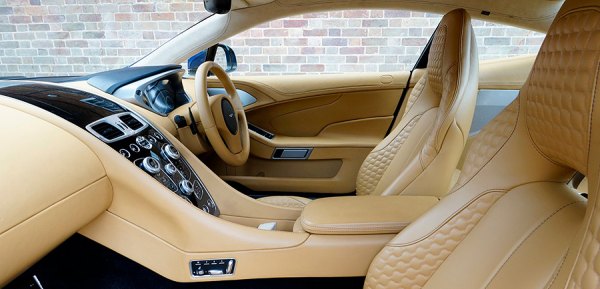
|
|
Vanquish
combines GT calmness with a certain level of sports car feel and sound.
|
|
The GT side of its manner can also be seen in the cabin.
Build quality and materials are certainly improved from any other
Astons bar One-77. The center console is finally completely redesigned
(remark: all Astons since DB9 share pretty much the same dash and
console). It features a smooth, lacquered surface and touch-sensitive
buttons with vibration feedback, much like mobile phones. However, the
best bit, i.e. a glass Start button, remains here to remind you this is
a bespoke British hand-built machine. Not so good is the audio system
and the Volvo-sourced infotainment system. Anyway, just listen to the
engine sound is already the best entertainment.
As the dashboard has been moved forward by 20 mm, the driver enjoys
more room. Door panels have also been reshaped to deliberate a bit more
elbow room. The rear seats, however, remain truly dog seats, but you
could choose to remove them. At the back, the boot now swallows a
decent 368 liters of luggage, 60 percent more than DBS.
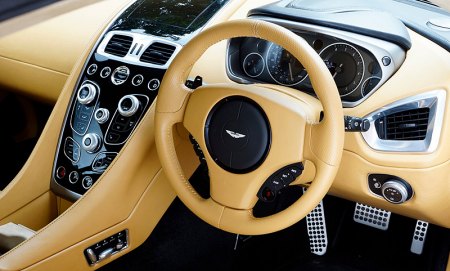 |
|
The
ZF 6-speed ZF auto has a significant contribution to the Vanquish' GT
manner, but it also hampers its driving thrills by equal degree.
|
|
The Vanquish is not perfect, of course. Its main weakness is
the 6-speed ZF automatic gearbox, which is neither as fast as modern
twin-clutch boxes nor as smooth as the newer ZF 8-speed auto. This
transmission has a significant contribution to the Vanquish' GT manner,
but it also hampers its driving thrills by equal degree. It makes the
car feel less accelerative and less sharp than it could have been. As a
result, it trails Ferrari F12 for driving thrills by a long long way.
The prancing horse feels far faster, sharper and more amazing, or in
other words, a supercar versus a GT. From this point of view, many
people may find the Aston's asking price of £190,000 probably too
much. On the plus side, the Aston is the more beautiful car in my eyes.
Its interior also looks more tasteful. Its character and bias are just
different from the Ferrari. Just like apple and orange, there is no
point for comparison.
|
Verdict:    |
Published
on 8
Aug 2014
|
All rights reserved.
|
|
Vanquish update 2014
|
|
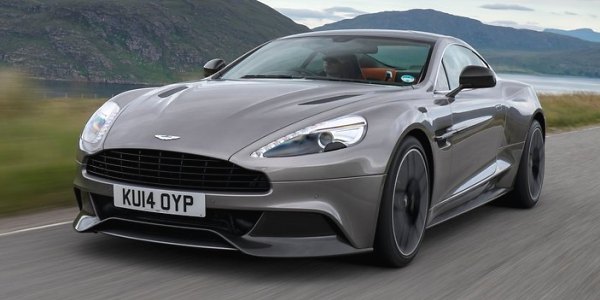
|
|
Now
Aston finally comes up with a solution it deserves: ZF 8-speed
automatic.
|
|
Beautiful, well balanced,
feelsome and great engine sound, the current Aston Martin Vanquish II
has many merits to qualify for a great GT. However, as pointed out in
my original review, it was seriously hampered by the outdated 6-speed
automatic gearbox. Now Aston finally comes up with a solution it
deserves: ZF 8-speed automatic.
You might wonder why it takes Aston so long to bring the ZF 8-speeder,
as the latter has been widely used by BMW, Audi, Jaguar etc. for a few
years already. The reason is Aston Martin’s VH architecture requires
the gearbox to be mounted at the rear axle for better balance, and ZF
did not build a transaxle version of the box – not even for Maserati.
Aston had to work together with ZF to adapt the 8HP to fit into its
existing transaxle casing. Further efforts were spent to reprogram its
shift patterns to suit the sportier character of Aston.
So how does the new box change the Vanquish? Surprisingly effective.
First of all, it releases the performance potential previously capped
by the lack of ratios. Now the 7th gear allows the Vanquish to register
a top speed of 201 mph, a far cry from the previously 183 mph. In fact,
it could have been Aston Martin’s fastest ever car if not the more
slippery Rapide S received the same treatment. Acceleration is also
much improved by the new gearbox, with 0-60 mph reduced from 4.0 to 3.6
seconds. It is still no match with Ferrari F12 or Porsche 911 Turbo S,
but it can now face the challenge of Mercedes SL63 AMG with confidence.
The next improvement is subjective feel. Gearshifts are now swift and
seamless, much faster and smoother than the old gearbox. Upshifts and
kickdowns are implemented at mostly the right moments, and it adapts to
your driving habits. While it is not as lightning quick as a
twin-clutch box for sure, it works so well that you are not aware of
its existence.
Finally, with additional ratios the 8-speeder also improves fuel
economy by 11 percent on average. This is evident when you cruise at 70
mph and see the engine registering just 1500 rpm at 8th.
Gearbox aside, the Vanquish also gets some other updates this time
around. Its V12 has been retuned to squeeze out another 3 horsepower
and 8 pound-foot of torque. Its brakes get retuned booster to improve
initial bite. Its suspensions get stiffer dampers (up 15% front and 35%
rear) and bushings for better control. To compensate, 7 kg of unsprung
weight has been removed by the use of lighter forged alloy wheels. On
the road, the stiffer suspension does make the ride harsher on rough
surfaces, but switch to Comfort mode can avoid most problems. However,
by far the most important change is still the gearbox. It finally
releases the potential of Vanquish and makes it a compelling choice
among classic GT cars.
|
Verdict:     |
Published on 31
Dec 2016
|
All rights reserved.
|
|
Vanquish S
|
|
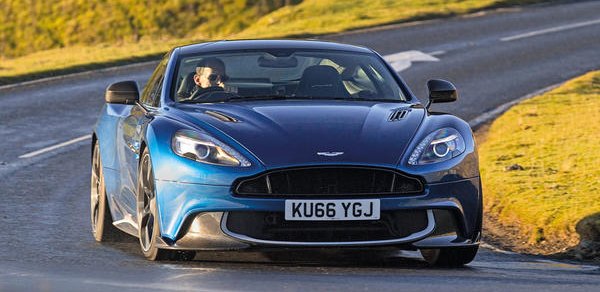
|
|
The
naturally aspirated motor asks you to work harder, and it rewards you
with greater noise and sharper throttle response...
|
|
Despite a new platform
introduced by DB11, Aston Martin’s range-topping Vanquish is set to
soldier on for a couple more years, so it needs to have another round
of mid-life refresh, and the result is Vanquish S. Outside, the
reshaped front splitter (made in carbon-fiber, of course) cuts
aerodynamic lift at 150 mph from the previous 66 kg to 18 kg while
without altering the drag coefficient of 0.37. It’s by no means a
benchmark for aerodynamics, but nonetheless a welcomed improvement. The
V12, still that naturally aspirated 5935 c.c. unit which started life
in 1999, gets larger intake manifolds for freer breathing, hence adding
24 horsepower for a neat 600. The peak power arrives at 7000 rpm or 350
rpm higher than before, which should delight keen drivers. Peak torque
is unchanged at a modest 465 lbft, although the torque band is said to
be available at a wider rev range. As a result, the Vanquish S takes
two-tenths less to reach 60 mph from standstill. It also gets a new
exhaust to improve sound.
And what a sound! It is louder and angrier than the old car’s, which
was already fabulous. While the new turbocharged V12 of DB11 has
certainly more mid-range shove hence allowing a more laid-back, relaxed
driving style, the Vanquish’s naturally aspirated motor asks you to
work harder, and it rewards you with greater noise and sharper throttle
response. That said, for everyday driving, cruising on motorway or
following traffics it never needs to rev beyond 2000 rpm, thus it is
perfectly refined. After all, this is still a big V12. The remapped ZF
8-speed automatic that sits at the rear axle seems to shift more
crisply, thanks to a stiffer connection between engine and transaxle.
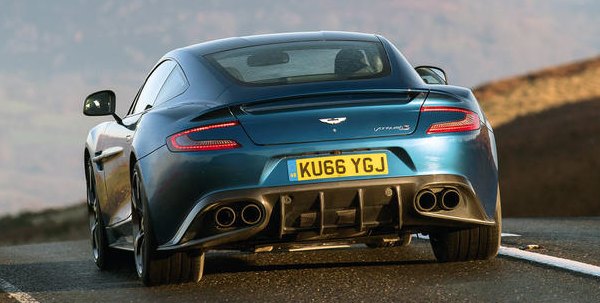
|
|
Suspension
mods make the big front-engined GT to feel much sportier and engaging...
|
|
The chassis is not forgotten either. Aston stiffened its front and rear
springs by 10 percent, thickened its rear anti-roll bar, firmed up its
suspension bushings and retuned its Bilstein adaptive dampers to suit.
These changes shift its yaw center forward thus reduce understeer. No
wonder the car now feels more agile to steer. The unaltered hydraulic
steering also seems to be benefited from the suspension mods. It feels
heavier and more connected to the road. As good as the DB11’s new
electrical rack, the Vanquish’s old-fashioned hydraulic steering is
still peerless for feel and consistency. Meanwhile, the stiffer
suspension improves the car’s primary ride, reduces roll and pitch on
bumps and ripples while leaving the road texture for your seat of the
pants to feel connected to the road. It is a very well-judged setup,
making the big front-engined GT to feel much sportier and engaging than
the old car as well as the DB11. A Ferrari F12 beater? Not that good,
but it certainly gets closer.
Where the Vanquish S falls short is the interior. It is still wrapped
in the best materials and finished with the best craftsmanship, but
compared with the DB11 its mechanical instrument looks outdated, its
screen too small and low resolution, and its infotainment system
hopelessly ancient. That won’t change until its ultimate replacement in
2019. Before then, enjoy the last rev of the old-school Aston!
|
Verdict:     |
|